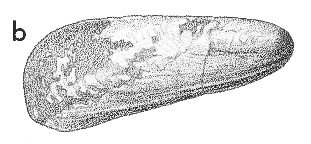
Revised descriptions of New Zealand Cenozoic Mollusca from Beu and Maxwell (1990)

 | Revised descriptions of New Zealand Cenozoic Mollusca from Beu and Maxwell (1990) | 
|
  (Pl. 45b): GS2665, T24/f7403, left bank of Manawatu River five km northeast of Kumeroa, southern Hawke's Bay, Nukumaruan (TM2137, GNS) |
Beu & Maxwell (1990): Chapter 16; p. 338; pl. 45 b.
Synonymy: Lithodomus striatus Hutton 1873b, p. 26; ? = Modiolus dolichus Suter 1917, p. 67; Lithophaga striata
Classification: Mytilidae: Modiolinae
Description: Moderate-sized for family; an exceedingly fragile, thin-shelled, smooth "mussel", up to about 80 mm long. Anterior end almost evenly hemispherical, umbones low but obvious, almost at anterior end; dorsal and ventral margins diverging at low angle; posterior end slightly compressed laterally and weakly truncated. The only sculpture is weak growth ridges on antero-ventral area. Interior highly nacreous, with no discernible teeth or muscle scars. Most specimens appearing nacreous on exterior also, or found as internal moulds.
Comparison: Little additional material of Amygdalum has come to light since Fleming (1959, p. 169) reviewed known localities and, under a heading for both A. striatum and A. dolichum, noted that "Material and data are as yet inadequate to decide the status of these nominal species". The relatively few specimens known from the Wanganui Series reach a larger size than Oligocene and Miocene specimens assigned to A. dolichum, but there appear to be no other consistent differences, and it seems likely that these belong in one species.
Amygdalum lives now in tropical and warm-temperate waters, byssally attached to hard substrates (boulders, logs, shells) well below the intertidal zone, and mostly in outer shelf to bathyal depths. Dell (1987) recently recorded the similar genera Adipicola Dautzenberg, 1927, Idasola Iredale, 1915 and Bathymodiolus Dell, 1987 living attached to logs in the bathyal zone around New Zealand, but there are no records of Recent Amygdalum from New Zealand. However, Beu (2004, p. 139) suggested that it is conspecific with (and an earlier name for) Amygdalum beddomei Iredale, 1924, living in southeastern Australia. Common mytilids from the "Modiolus limestone" facies of northern Wairarapa to near East Cape appear to be a large species of a genus similar to Bathymodiolus (to 100 mm long), differing from Amygdalum in having a more marked umbonal-ventral ridge, and in having more prominent umbones further behind the anterior end.
Distribution: Duntroonian-Haweran (A. dolichum: Duntroonian-Altonian; A. striatum: Kapitean-Haweran). "Shakespeare Cliff', Wanganui, Castlecliffian? (type of Lithodomus striatus; Weka Pass, North Canterbury (Altonian?; Waiauan?) (type of Modiolus dolichus). Most of the more recently collected specimens of Amygdalum striatum are from either the Kai-Iwi siltstone beds or Tainui Shellbed at Castlecliff, and Tainui Shellbed seems likely to be the type horizon. It is also relatively common at a few localities in Tokomaru Sandstone (Kapitean) near Tokomaru Bay, Gisborne district. The youngest record is from Landguard Sand (Haweran, oxygen isotope stage 9) at Wanganui.
Cite this publication as: "A.G. Beu and J.I. Raine (2009). Revised
descriptions of New Zealand Cenozoic Mollusca from Beu and Maxwell (1990). GNS
Science miscellaneous series no. 27."
© GNS Science, 2009
ISBN
978-0-478-19705-1
ISSN 1177-2441
(Included with a PDF facsimile file
copy of New Zealand Geological Survey Paleontological Bulletin 58 in CD version
from: Publications Officer, GNS Science, P.O. Box 30368 Lower Hutt, New
Zealand)